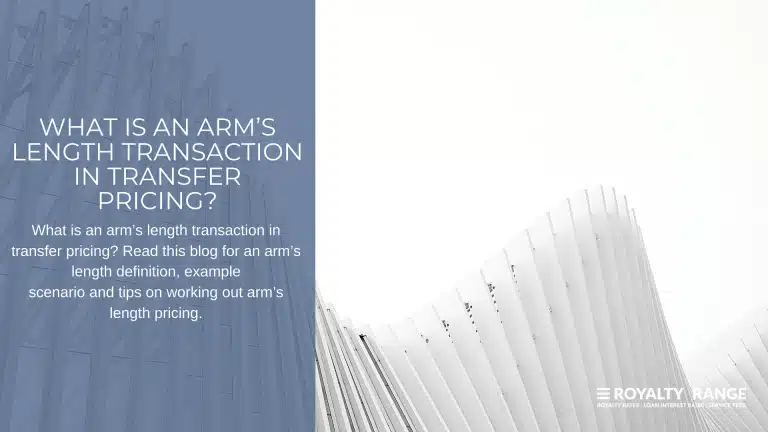What is an arm’s length transaction in transfer pricing?

Kris (Kestutis) Rudzika |
December 11, 2020

When your company is made up of multiple legal entities, those entities often transfer goods, services and intellectual property between each other. If this is the case with your organization, you need to make sure that those transactions happen at arm’s length. This is essential for ensuring your organization is tax-compliant. But what does ‘at arm’s length’ mean? What is an arm’s length transaction? Read on for an arm’s length definition, why it is important, and how to calculate arm’s length pricing for your intercompany transactions.
Arm’s length definition
The term ‘at arm’s length’ simply means that a transaction between related entities reflects the conditions and remuneration set in comparable transactions between unrelated entities.
The OECD says this about the arm’s length principle:
“This valuation principle is commonly applied to commercial and financial transactions between related companies. It says that transactions should be valued as if they had been carried out between unrelated parties, each acting in his own best interest.”
What is an arm’s length transaction in transfer pricing?
When one legal entity within your company transacts with another, you need to set a transfer price for the transaction. This transfer price needs to be at arm’s length.
Why? To ensure that your organization profits fairly from intercompany transactions.
But what is an arm’s length transaction in transfer pricing? It means that the price a company pays to purchase goods or services from a related company entity should be the same as if the two entities were unrelated. In other words, there should be no price adjustment or special conditions for the transaction simply because the parties are related legal entities.
Why is it important for transactions to be at arm’s length?
The arm’s length principle is a way of ensuring that organizations with multiple legal entities in different jurisdictions are tax-compliant and do not profit unfairly (accidentally or intentionally) from transacting between its related entities. It provides organizations with a simple principle for determining fair, tax-compliant prices and terms for intercompany transactions, as well as empowering tax bodies to tackle base erosion and profit shifting in multinational enterprises (MNEs).
Example of an arm’s length transaction
If you’re still wondering ‘What is an arm’s length transaction?’, here is an example (made up):
Nutrition To Go is a multinational company that manufactures and sells health foods and nutritional supplements globally. It is based in the US and has subsidiary entities in China, Singapore and the UK. Its China entity, Eco-Pack, designs and manufactures biodegradable packaging, such as standup pouches and vitamin bottles, for the global health foods market.
Eco-Pack has agreed to supply Nutrition To Go with product packaging on an ongoing basis.
As the parent company, Nutrition To Go needs to ensure that it pays a fair, arm’s length price for Eco-Pack’s packaging. The cost that Nutrition To Go pays for the packaging (as Eco-Pack’s parent company) should be the same as what an unrelated, independent party would pay.
In order to ensure that the intercompany pricing is at arm’s length, Nutrition To Go conducts a transfer pricing analysis for the transaction. It uses a royalty rates database to identify comparable transactions between unrelated entities, and uses the remuneration set in these transactions as a guide for its own transfer pricing. It lays this out in a licensing agreement (also known as a royalty agreement) with Eco-Pack, which both parties agree to.
As the transfer price that Nutrition To Go sets reflects what would have been charged had the transaction occurred between two unrelated parties, it can be said to be at arm’s length.
Calculating arm’s length transfer prices for an intercompany transaction
There are a number of transfer pricing methods you can use to determine arm’s length transfer prices for your intercompany transactions. These include the comparable uncontrolled price (CUP) method, the resale price method, the cost plus method, the transactional net margin method (TNMM), and the transactional profit split method.
The most suitable method depends on the individual circumstances of your analysis.
As long as you have access to reliable comparables data, the CUP method is considered the most direct way to apply the arm’s length principle. It involves analyzing the royalty rates set in comparable licensing agreements between unrelated entities, and using these as a starting point for setting fair transfer prices for the intercompany transactions being analyzed.
Find comparables data to help you set arm’s length transfer prices today
You can find the licensing agreements and royalty rates data you need in the RoyaltyRange database. It can be used with the CUP method and all the other transfer pricing methods.
To start searching the RoyaltyRange database, use the One Search box on the right.
Request One Search
We will perform the search and deliver the initial results within hours, at no cost.




